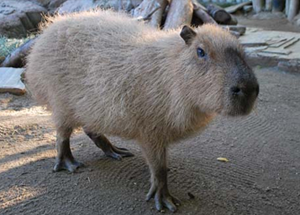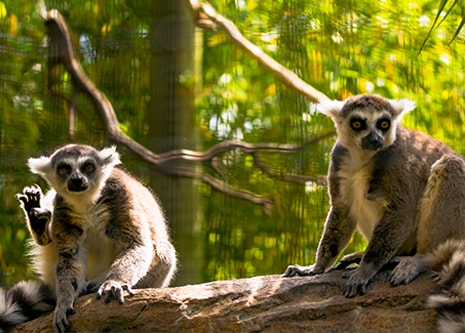
- VisitSupport Happy HollowDONATE TODAYExploreSupport Happy HollowDONATE TODAYLearnSupport Happy HollowDONATE TODAYSupport
-
Today's Hours: 10:00 am to 4:00 pm
Zoo in the HollowCapybara

Scientific name: Hydrochoerus hydrochaeris
Family: Caviidae
Order: Rodentia
Class: Mammalia Range: South America
Habitat: Subtropical and Tropical Forest, Wetland Lifespan: 8 to 10 years in the wild; Up to 12 years in captivityWhat do they look like?
Capybaras are the largest rodents in the world. As a relative of the guinea pig, capybaras look like a super-sized version of their smaller cousins. They stand about two feet tall and can weigh up to 150 pounds. They have barrel-shaped bodies with rectangular heads. As prey animals, their eyes are located on the sides of their heads for maximized peripheral vision. They are covered in coarse hair and have partially webbed toes that allow them to glide through the water and stay atop muddy marshlands without sinking.How do they behave?
Capybaras are social animals and typically live in groups of 10 to 30 individuals led by a dominant male, though groups have been recorded at up to 100 individuals. They communicate with one another through a variety of barks, chuffs, chirps and clicks. The variety of vocal calls allows for mothers to communicate with young, males with females, and to send warning calls within a group when a predator is near. They also communicate through scent, as capybaras have scent glands located on the top of their noses. Capybaras are often found in or near water. While these habitats provide an abundance of food, capybaras use moving water for another purpose. These rodents nearly always defecate in the water. It is thought that by using the water as a toilet, it will wash away or reduce the scent of the capybaras, making it less likely for predators to find them. They can also hold their breath for up to five minutes! Once thought to be diurnal, capybaras are now known to be crepuscular (most active at dawn and dusk), and may even forage at night to avoid predators. Their predators include anacondas, jaguars, ocelots and caiman.What do they eat?
In the wild, capybaras eat the plants and grasses that grow in the marshy areas in which they live. Capybaras can eat six to eight pounds of plant material each day. They chew from side to side rather than up and down, grinding tough plants up more efficiently with their long rows of flat molars. Capybaras have also been known to participate in caecotrophy (eating their own feces to absorb more nutrients). At Happy Hollow, the capybaras eat grass hay, specially formulated rodent pellets, beet pulp, fruits and vegetables.How are they born?
Female capybaras usually give birth to one litter of young per year, though if conditions permit, a second litter may be born later in the year. The typical gestation period is five to six months. Baby capybaras are able to walk shortly after birth. Capybaras develop quickly and have been observed starting to eat grasses as early as one or two days old, but also continue to nurse for up to 16 weeks.Conservation
The conservation status of the capybara is currently listed as Least Concern by the International Union for Conservation of Nature . Although capybaras are at stable populations in the wild, they are often hunted by locals as a food source and are losing their homes due to deforestation and human encroachment. To help protect wild capybaras and all animals that share their rainforest habitat, the Central Suriname Nature Reserve was established in the year 2000. If you would like to help wild capybaras you can encourage your friends to purchase coffee that is shade-grown and produce that is grown locally. These products do not require the destruction of rainforest land to grow crops and they will help out your local economy.
Zoo on the Hill
Located across from the Keep-Around Carousel is the Zoo on the Hill. Learn about wildlife up close during daily meet-and-greets, leap like a lemur on the playground, brush and feed the goats,, or take a peek inside Doc’s Critter Care building and the Ranch House. Double-H Ranch features a combination of animal exhibits, including giant anteaters and red ruffed lemurs, as well chickens and domesticated animals that are docile enough to touch.
See Animals
Education Ambassadors
From camps and classes to scout badges and sleepovers, Happy Hollow education programs have something for everyone! The zoo education program offers a broad range of hands-on, engaging programs and public presentations featuring education ambassador animals. These encounters are designed to connect you to wildlife and the conservation of their habitats around the world.
See AnimalsVisit Us Today
Plan an unforgettable experience at San Jose’s family-friendly park and zoo.
Learn More